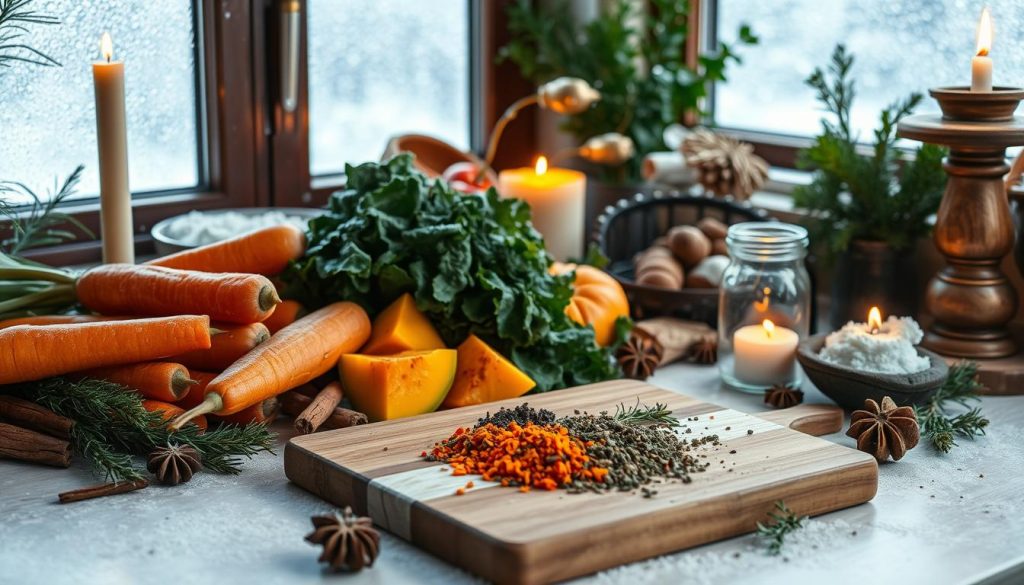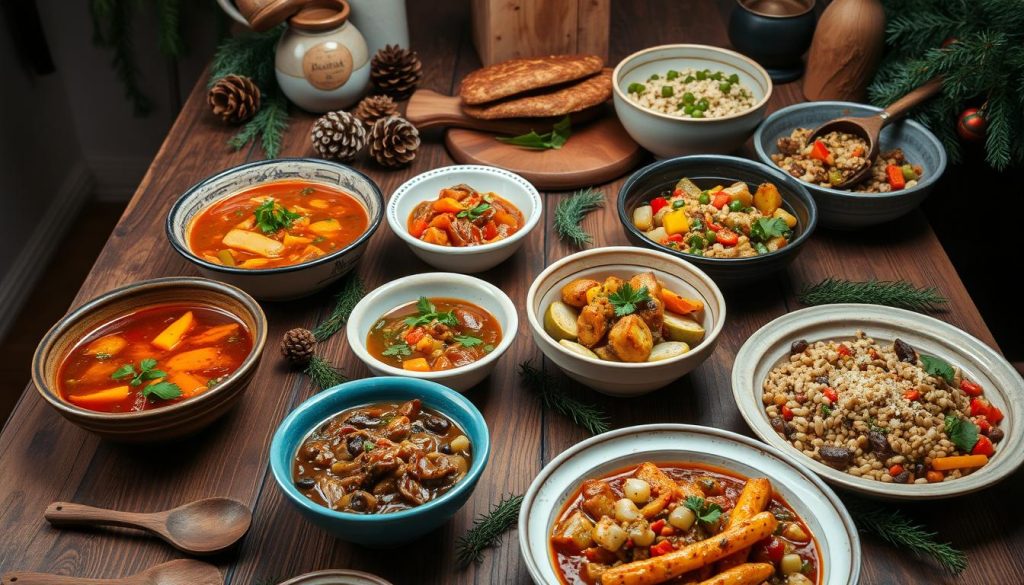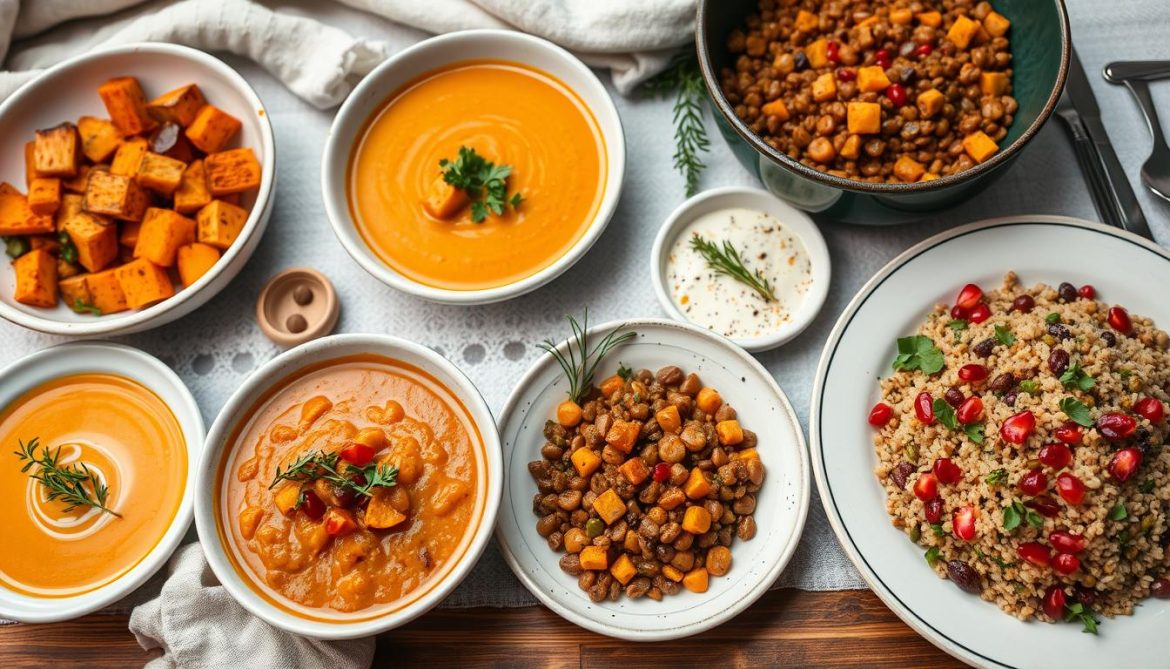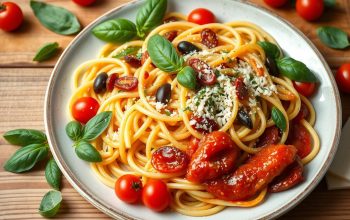Winter is a magical time to explore hearty vegetarian dishes. These meals warm our bodies and souls. In the kitchen, I turn simple ingredients into amazing meals with vibrant vegetables and rich flavors.
Cooking vegetarian winter dishes is more than just avoiding meat. It’s a journey of finding incredible plant-based recipes. These dishes, from roasted root vegetables to creamy grain bowls, show that winter eating can be exciting and healthy.
Seasonal cooking is an art, and each ingredient has its own story. Whether you’re a vegetarian or just looking for meat-free options, this guide will inspire you. It will help you create meals that comfort and delight!
Get ready to explore a world of delicious possibilities. We’ll learn new techniques, ingredients, and recipes for amazing winter meals. Your kitchen is about to become a place of flavor and creativity!
Embracing the Season with Plant-Based Comfort Foods
Winter is a magical time to explore seasonal vegetable cuisine. As it gets colder, we all crave warmth and comfort. Plant-based recipes are perfect for staying healthy and happy during the coldest months.
Let’s explore the delicious world of winter nutrition. Discover how seasonal eating can change your cooking!
Understanding Winter Nutrition Needs
Winter means we need more energy to stay warm and fight off colds. Nutrient-dense plant-based recipes are key during these months:
- Higher calorie intake to maintain body temperature
- Increased immune-boosting ingredients
- Hearty, warming meals that provide sustained energy
Benefits of Seasonal Eating
“Eating with the season is like giving your body a natural nutrition passport.” – Local Food Expert
Seasonal vegetable cuisine has many benefits:
| Benefit | Description |
|---|---|
| Nutrition | Peak vitamin and mineral content |
| Cost | Lower prices for locally grown produce |
| Environment | Reduced carbon footprint |
Building a Balanced Vegetarian Plate
Creating satisfying plant-based meals needs careful planning. Focus on these key components:
- Protein-rich legumes and grains
- Colorful seasonal vegetables
- Healthy fats from nuts and seeds
- Complex carbohydrates for sustained energy
By following these tips, you’ll make delicious, nutritious winter meals. These meals will keep you warm, healthy, and completely satisfied!
Essential Winter Vegetables for Meatless Meals
Winter is a time for delicious vegetables that are great for meatless meals. These seasonal gems are full of nutrients and add amazing flavors to your dishes.
Let’s look at some top winter vegetables for your kitchen:
- Kale: A nutrient-dense leafy green packed with vitamins and minerals
- Brussels sprouts: Roasted to crispy perfection
- Parsnips: Sweet and earthy root vegetable with incredible depth
- Butternut squash: Creamy and versatile for multiple meatless meals
- Swiss chard: Vibrant and tender winter green
To cook these veggies, you need to know their special traits. Roasting brings out sweet flavors, while sautéing keeps them tender. Try different ways to cook them for exciting vegetable medleys.
“Winter vegetables are nature’s gift to creative home cooks, offering endless possibilities for delicious, nutritious meals.” – Seasonal Cooking Magazine
For stunning meatless meals, mix different textures and colors. Combine roasted root veggies with tender greens. Season with bold herbs and spices.
Root Vegetables: The Foundation of Winter Cooking
Winter brings a treasure trove of root vegetables. They transform seasonal vegetable cuisine into heartwarming culinary experiences. These underground gems are packed with nutrients and offer incredible versatility for creating hearty vegetarian dishes that comfort and nourish.
Root vegetables are the unsung heroes of winter cooking. Their rich, earthy flavors and dense textures make them perfect for creating satisfying meals. These meals keep you warm during cold months.
Storage and Preparation Tips
- Store root vegetables in a cool, dark place with good air circulation
- Keep potatoes and onions separate to prevent sprouting
- Clean vegetables just before cooking to maintain freshness
- Use perforated bags or vegetable storage containers
Roasting Techniques for Maximum Flavor
Roasting transforms root vegetables into caramelized, flavor-packed delights. The key is high heat and proper seasoning.
- Cut vegetables into uniform sizes for even cooking
- Toss with olive oil and robust herbs
- Spread on a single layer on baking sheet
- Roast at 425°F for 30-45 minutes
Creative Root Vegetable Combinations
| Vegetable Pairing | Flavor Profile | Cooking Method |
|---|---|---|
| Sweet Potato & Parsnip | Sweet and Nutty | Roasted |
| Beet & Carrot | Earthy and Vibrant | Glazed |
| Turnip & Rutabaga | Mild and Creamy | Mashed |
“Root vegetables are winter’s hidden culinary treasures, waiting to be transformed into delicious masterpieces.” – Chef Emma Roberts
Embrace these underground wonders in your seasonal vegetable cuisine. Discover the magic of hearty vegetarian dishes that warm both body and soul.
Warming Soups and Stews for Cold Evenings
Winter evenings are perfect for a special treat – a vegetarian delight that warms you up. Soups and stews turn simple ingredients into comforting meals. They chase away the cold and soothe your soul.
“A good soup can heal the soul and warm the heart” – Kitchen Wisdom
Let’s explore hearty vegetarian soups for memorable winter nights. The secret is in layering flavors and picking the right ingredients.
- Roasted butternut squash soup with sage
- Wild mushroom and barley stew
- Spicy lentil and vegetable chowder
- Creamy cauliflower and white bean soup
To make the perfect winter soup, roast vegetables first. This boosts their sweetness and depth. Herbs and spices are key to making simple ingredients amazing.
| Soup Type | Key Ingredients | Cooking Time |
|---|---|---|
| Butternut Squash Soup | Roasted squash, onions, vegetable broth | 45 minutes |
| Mushroom Stew | Mixed mushrooms, thyme, barley | 1 hour |
| Lentil Chowder | Red lentils, root vegetables, cumin | 50 minutes |
Pro tip: Make extra and freeze it for quick meals. These vegetarian delights are not just comfort food. They’re also packed with nutrition to keep you warm and satisfied all winter.
Pro Chef’s Secret: Begin with sautéed aromatics like onions, garlic, and herbs. They add depth to your comforting vegetarian fare.
Vegetarian Winter Delight: Classic Recipes Reimagined
Winter cooking turns into a fun journey when you make old recipes new again. Plant-based dishes bring a fresh twist to comfort foods. They warm your heart and body.
Let’s dive into how classic dishes can be made over with plant-based ingredients. These ingredients add amazing flavor and health benefits.
Traditional Adaptations with a Twist
Changing classic winter recipes doesn’t mean losing flavor or enjoyment. Here are some tasty vegetarian winter delights:
- Shepherd’s pie with lentils and mushroom gravy
- Creamy cauliflower “alfredo” pasta instead of dairy
- Jackfruit “pulled pork” sandwiches with a smoky taste
Modern Culinary Innovations
Plant-based recipes are breaking new ground in winter cooking. Here are some fresh ideas:
| Classic Dish | Vegetarian Transformation | Key Ingredients |
|---|---|---|
| Beef Stew | Hearty Mushroom Bourguignon | Portobello mushrooms, red wine, herbs |
| Meatballs | Quinoa-Lentil Protein Balls | Quinoa, lentils, nutritional yeast |
| Chili | Three-Bean Winter Chili | Black beans, kidney beans, chickpeas |
“Cooking is about passion, creativity, and transforming ingredients into something magical.” – Unknown Chef
By trying these vegetarian winter delights, you’ll find a world of flavors. You’ll see that plant-based recipes can be just as good as traditional ones.
Protein-Rich Winter Alternatives to Meat
Winter calls for hearty, satisfying meals that keep us warm and nourished. For those looking for meatless options, finding protein-rich alternatives is an exciting journey. Plant-based proteins can turn your vegan winter dishes into nutritious, tasty meals.
Let’s explore the world of protein powerhouses that will delight your taste buds and nourish your body:
- Legumes: Black beans, lentils, and chickpeas are big on protein
- Tofu and Tempeh: These versatile proteins soak up flavors beautifully
- Seitan: The wheat protein that perfectly mimics meat textures
For your winter kitchen, try creative marinades and cooking methods. Imagine turning tofu into crispy cubes for a hearty stew or making a spicy lentil curry that warms you up!
“Protein isn’t just about muscle—it’s about creating satisfying, nourishing meals that celebrate plant-based ingredients.” – Plant-Based Chef
Pro tip for mastering meatless meals: Mix up your protein sources and seasonings. A bit of smoked paprika or tamari can make your vegan winter dishes truly special.
| Protein Source | Protein per Cup | Additional Benefits |
|---|---|---|
| Lentils | 18 grams | High in fiber, iron |
| Chickpeas | 15 grams | Rich in minerals |
| Tofu | 20 grams | Calcium, low calories |
Your winter kitchen is about to become a protein paradise—get ready to explore, create, and enjoy!
Hearty Grain Bowls and Winter Risottos
Winter is the perfect time for warm, comforting meals. Hearty vegetarian dishes are ideal for these chilly months. They turn simple grains into amazing dishes. Grain bowls and risottos are great for creative winter cooking.
Ancient Grains: Nutritional Powerhouses for Modern Meals
Discover the power of ancient grains for delicious winter meals. These grains add amazing texture and flavor to your dishes.
- Quinoa: A complete protein packed with essential amino acids
- Farro: Rich in fiber and complex carbohydrates
- Barley: Provides excellent heart-healthy benefits
Mastering the Art of Perfect Risotto
Making the perfect risotto takes patience and skill. Choose winter veggies like butternut squash and wild mushrooms to make it special.
| Grain | Cooking Time | Liquid Ratio |
|---|---|---|
| Arborio Rice | 18-20 minutes | 1:3 rice to liquid |
| Quinoa | 15 minutes | 1:2 quinoa to liquid |
| Farro | 25-30 minutes | 1:3 farro to liquid |
“A great grain bowl is like a warm embrace on a cold winter day – comforting, nourishing, and full of love.”
For delicious vegetarian dishes, try toasting grains first. Use rich vegetable stocks and add roasted seasonal veggies. Your winter meals will be exciting and full of flavor!
Seasonal Spices and Herbs for Winter Dishes

Spice up your winter dishes with amazing herbs and spices. They turn simple vegan meals into unforgettable experiences. Winter cooking is all about adding depth, warmth, and complexity to every bite.
Let’s dive into the magical world of winter spices. They can make your plant-based dishes stand out:
- Warming Spices: Cinnamon, nutmeg, and cloves add rich, comforting flavors to winter dishes
- Savory Herbs: Rosemary, thyme, and sage create aromatic profiles in vegetable roasts
- Heat Boosters: Chili peppers and cayenne add exciting kick to vegan winter warmers
“Spices are the secret weapons of winter cooking – they transform simple ingredients into memorable meals.”
Learning to layer and combine spices can greatly enhance your dishes. Try spice blends like garam masala, za’atar, or your own mix. This will create unique flavors that excite your taste buds.
Pro tip: Toast whole spices briefly before grinding to unlock their most intense flavors. This technique is great for dishes like roasted vegetable medleys or hearty winter stews.
Comforting Casseroles and Bakes
Winter is the perfect time for warm, comforting meals. Hearty vegetarian dishes are a highlight of the season. They turn simple ingredients into delicious, soul-warming food that delights and warms your heart.
Casseroles are the ultimate comfort food for winter. They bring together amazing flavors, textures, and nutrition in one dish. Let’s dive into some top tips for making unforgettable baked dishes.
Make-Ahead Magic
Preparing casseroles ahead of time saves time on busy weeknights. Here are some smart tips:
- Chop vegetables the night before
- Pre-cook grains and legumes
- Assemble casserole parts in advance
- Store them in airtight containers
Freezer-Friendly Tips
Freezing casseroles can change your meal planning game. Here are some expert tips:
- Use freezer-safe glass or ceramic dishes
- Let dishes cool completely before freezing
- Wrap tightly with plastic wrap and aluminum foil
- Label with date and contents
- Enjoy within 2-3 months for best taste
“A well-prepared casserole is like a warm hug for your stomach!” – Culinary Enthusiast
Mastering these techniques turns simple ingredients into amazing vegetarian dishes. They are satisfying and nourishing. Start baking and enjoy the comfort of vegetarian meals this winter!
Winter Squash Varieties and Their Uses
Winter squash makes seasonal vegetable dishes vibrant and delicious. These hearty vegetables add warmth, nutrition, and flavor to your meals in winter.
Let’s dive into the amazing world of winter squash varieties. They can take your cooking to new heights!
- Butternut Squash: Creamy and sweet, perfect for soups and roasting
- Acorn Squash: Nutty flavor, ideal for stuffing
- Kabocha Squash: Rich, dense texture great for purees
- Spaghetti Squash: Low-carb pasta alternative
- Pumpkin: Versatile for both savory and sweet dishes
Each squash has its own special traits that make them shine in vegetarian dishes. Choosing the right squash can turn a simple meal into a masterpiece!
“Winter squash is nature’s gift to seasonal cooking – packed with flavor and nutrition!” – Seasonal Chef
| Squash Variety | Flavor Profile | Best Cooking Method |
|---|---|---|
| Butternut | Sweet, Nutty | Roasting, Purees |
| Acorn | Mild, Slightly Peppery | Stuffing, Baking |
| Kabocha | Rich, Earthy | Steaming, Soup |
When cooking winter squash, always wash it well. Use sharp knives and try different cooking methods. This will help you bring out the best flavors in your dishes.
Plant-Based Winter Appetizers and Sides
Winter gatherings are the perfect time for amazing plant-based recipes. These dishes will impress your guests and warm their hearts. I’ve found some incredible vegetarian winter delight appetizers that turn simple ingredients into masterpieces.
Party-Perfect Portions
Creating memorable vegetarian winter appetizers needs creativity and planning. These small dishes let everyone enjoy a taste without feeling full.
- Mini roasted vegetable tartlets
- Crispy butternut squash croquettes
- Spiced cauliflower bites
- Winter herb-infused bruschetta
Presentation Ideas
Great presentation makes plant-based recipes stand out. Use rustic wooden boards, slate platters, or colorful ceramic dishes to show off your dishes.
| Appetizer | Serving Suggestion | Prep Time |
|---|---|---|
| Roasted Vegetable Tartlets | Marble serving platter | 30 minutes |
| Cauliflower Bites | Wooden geometric tray | 45 minutes |
| Winter Bruschetta | Slate appetizer board | 20 minutes |
“The secret to great appetizers is balancing flavors and creating visual appeal.” – Chef Emma Green
With these plant-based recipes, you’ll make any winter gathering unforgettable. Everyone will remember the amazing food!
Meal Planning for Winter Vegetarian Success

Planning your vegetarian meals for winter doesn’t have to be hard. With a smart plan, you can make your meatless meals exciting and healthy. This way, you’ll love cooking and stay full of energy.
Here are some tips to make your winter cooking easy and tasty:
- Create a weekly template that balances different types of meatless meals
- Prep ingredients in advance to save time during busy weekdays
- Develop a flexible approach to winter vegetarian cooking
Understanding your schedule and nutritional needs is key. Winter calls for hearty, warming meals that comfort and nourish. Build a collection of versatile vegetarian dishes that can be easily changed or reused.
“Meal planning is your secret weapon for consistent, delicious vegetarian winter cooking!” – Professional Home Chef
Here are some practical tips for a successful vegetarian winter meal plan:
- Batch cook staple ingredients like grains and roasted vegetables
- Stock your pantry with winter spices and essential vegetarian proteins
- Invest in storage containers for easy meal prep and leftovers
By following these tips, you’ll make your winter cooking easy and enjoyable. Your meatless meals will become something to look forward to, not something to worry about!
Winter Produce Shopping Guide
Exploring the winter produce aisle is a fun journey for anyone who loves seasonal vegetables. Your vegetarian winter delight begins with picking the freshest, tastiest ingredients.
Shopping for winter vegetables needs a sharp eye and some insider tips. Here are my best strategies for finding the best seasonal produce. They’ll turn your kitchen into a winter culinary wonderland!
Selecting Quality Ingredients
When searching for the perfect winter produce, remember these key tips:
- Choose firm, heavy vegetables with bright colors
- Steer clear of produce with soft spots, bruises, or color changes
- Look for smooth, unblemished skin on squashes and root vegetables
Budget-Friendly Options
Creating a tasty seasonal vegetable cuisine doesn’t have to cost a lot. Here are smart ways to save:
- Buy seasonal vegetables at their peak freshness
- Shop at local farmers markets
- Think about frozen vegetables as a budget-friendly option
| Vegetable | Average Price | Best Season |
|---|---|---|
| Butternut Squash | $1.50/lb | Fall/Winter |
| Carrots | $0.99/lb | Year-round |
| Kale | $2.99/bunch | Winter |
“The secret to great cooking is finding the freshest ingredients at the best price.” – Local Farmers Market Wisdom
Pro tip: Don’t be afraid of “imperfect” produce. These often-overlooked vegetables can be just as tasty and are usually cheaper!
Nutritional Considerations for Winter Vegetarians
Making tasty vegetarian meals in winter is more than just skipping meat. It’s about keeping your body strong and full of energy. As someone who loves cooking plant-based, I’ve found that you need to plan carefully to get all the nutrients.
Now, let’s look at the important nutrients vegetarians need in winter:
- Vitamin D: It helps your immune system and mood.
- Iron: It’s key for energy and carrying oxygen.
- Vitamin B12: It’s vital for your nerves and blood cells.
- Protein: It keeps your muscles strong and healthy.
Winter vegetarian diets can be very healthy with the right foods. There are many plant-based proteins to choose from. Try adding these nutrient-rich foods to your meals:
| Nutrient | Top Plant-Based Sources | Serving Size |
|---|---|---|
| Protein | Lentils, quinoa, tofu | 1/2 cup cooked |
| Iron | Spinach, beans, fortified cereals | 1 cup |
| Vitamin D | Mushrooms, fortified plant milk | 1 cup |
| B12 | Nutritional yeast, fortified foods | 2-3 tablespoons |
Pro tip: Mix iron-rich foods with vitamin C to boost absorption!
“Nutrition is not about restriction, but about creating delicious, nourishing meals that fuel your body.” – Plant-Based Nutrition Expert
By choosing the right ingredients and knowing what you need, you can make meals that are both tasty and healthy. Winter doesn’t mean you have to give up on health. It’s a chance to try new, nutritious vegetarian dishes!
International Vegetarian Winter Recipes
Winter is more than just local food – it’s a chance to explore the world’s flavors! Plant-based recipes from around the globe can make your winter meals exciting and warm.
Let’s go on a tasty trip to two amazing places known for their hearty vegetarian dishes.
Asian-Inspired Winter Dishes
Asian foods are known for their creativity and depth in vegetarian cooking. Here are some must-try winter dishes:
- Japanese Nabe (hot pot) with seasonal mushrooms
- Korean vegetable Bibimbap with roasted winter vegetables
- Chinese Buddha’s Delight with winter greens
These dishes offer unique tastes that turn simple ingredients into amazing vegetarian meals. The secret is in the spices and cooking methods.
Mediterranean Winter Fare
Mediterranean food is famous for its rich, satisfying vegetarian dishes. These winter recipes will warm your heart:
- Greek Gemista (stuffed vegetables)
- Spanish Vegetable Paella
- Italian Ribollita soup
“Cooking is about passion, and these international recipes capture the heart of winter comfort!” – Chef Maria Rodriguez
Adding global flavors to your meals can make them truly special. Try these international recipes and open up a world of delicious flavors!
Kitchen Tools and Equipment for Winter Cooking
Winter cooking needs special tools to make dishes stand out. My kitchen has versatile tools for making vegan winter dishes. A heavy-duty Dutch oven is key for rich stews with seasonal veggies and spices.
Quality tools don’t have to be expensive. A good chef’s knife, sturdy cutting board, and reliable sheet pan can make a big difference. Le Creuset and Staub offer great cast-iron cookware for slow-cooking. Lodge also has affordable cast-iron options that work well.
Special equipment can make winter cooking fun. An immersion blender turns root veggies into creamy soups. A high-powered food processor quickly chops ingredients. Slow cookers and Instant Pots are also great for easy, hearty dishes.
The right tools make winter cooking fun and easy. From kitchen scales to mandoline slicers, each tool offers new ways to make tasty vegan dishes. These dishes warm both body and soul.



